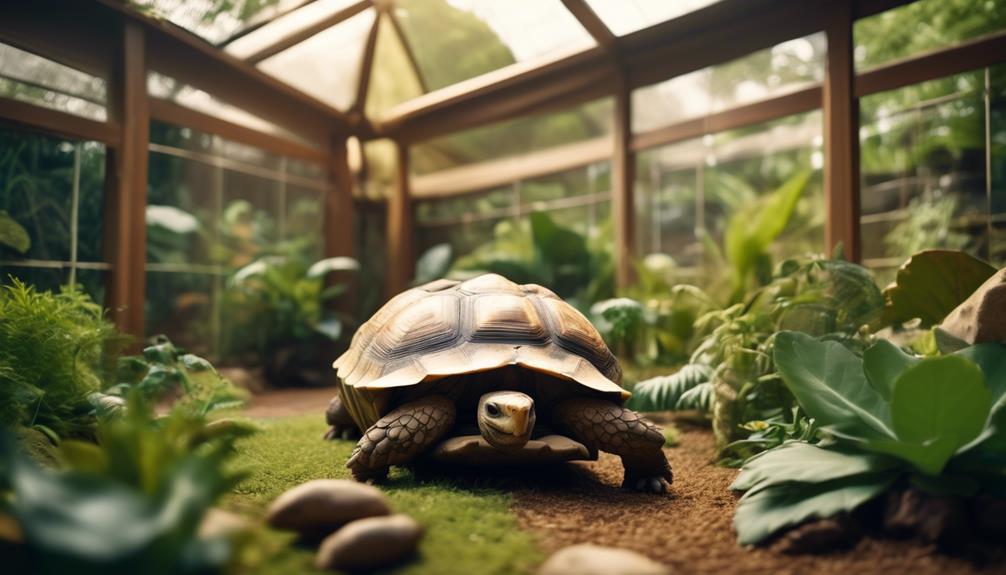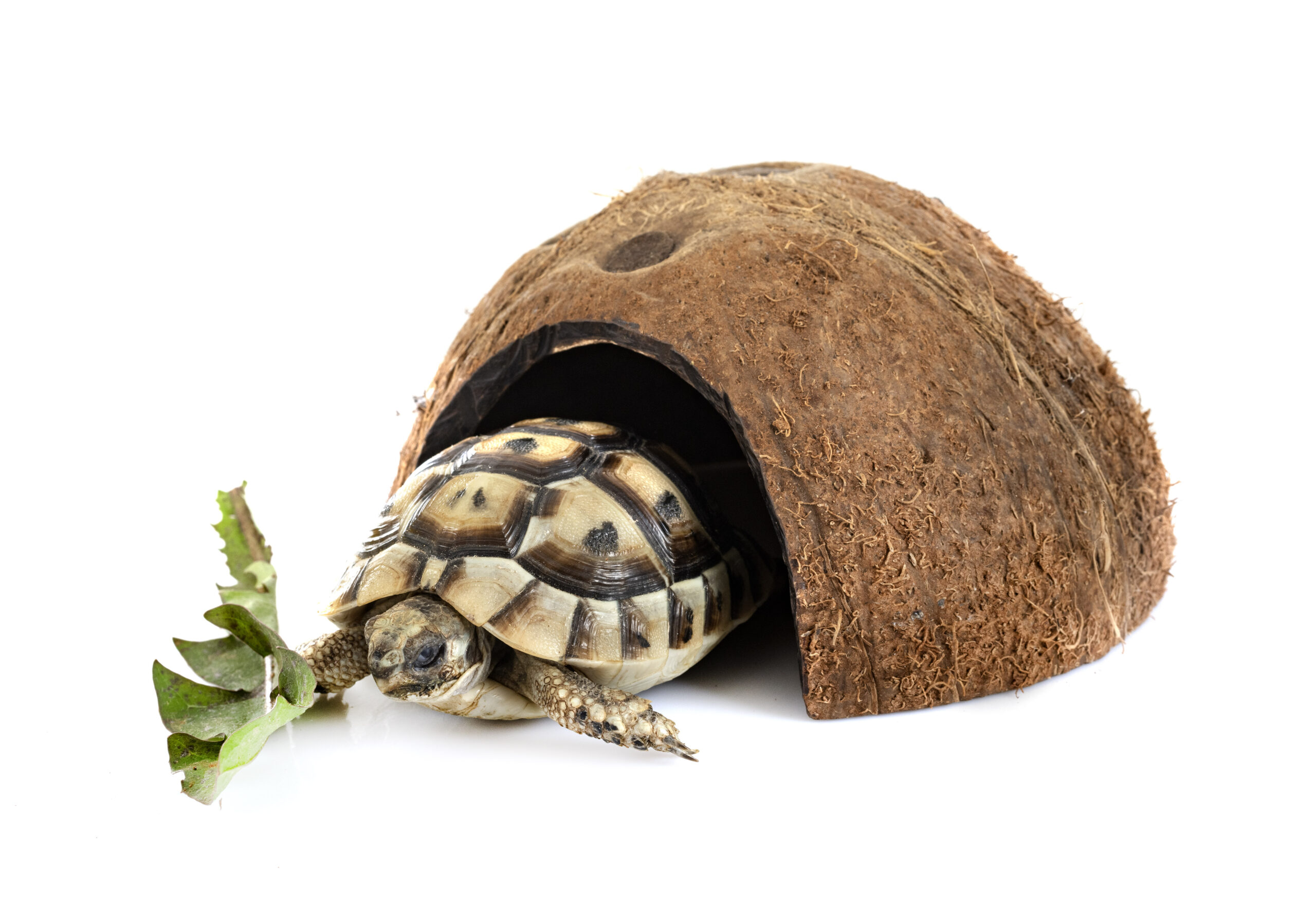Welcome to our guide on turtles mating! Breeding box turtles can be a captivating experience, whether you’re doing it for profit or personal enjoyment. In this article, we will explore the steps and considerations involved in successfully breeding turtles, as well as provide valuable insights into the fascinating world of turtle reproduction.
Key Takeaways:
- Breeding box turtles requires finding a healthy pair of opposite-gender turtles of the same species.
- Setting up the proper enclosure with fresh water, a heat lamp, hiding spaces, and a balanced diet is essential for successful breeding.
- Understanding the breeding season, timing of egg laying, and caring for the eggs and hatchlings are crucial for successful reproduction.
- Sea turtles also have their own mating seasons, and conservation efforts are crucial for their survival.
- There are various recommended books available for further exploration of turtles and their care.
Finding a Suitable Pair of Turtles
When it comes to breeding box turtles, finding a suitable pair is crucial for successful reproduction. You’ll want to ensure that the turtles are of opposite gender and the same species. Avoid breeding related turtles to prevent genetic abnormalities. Sexing the turtles can be a bit challenging, but there are visual cues that can help determine their gender. For example, males may have red eyes, while females may have a concave curve on the bottom of their shell.
If you’re unsure about sexing the turtles yourself, it’s recommended to take them to a veterinarian for a proper examination. A vet check is essential to accurately identify the gender of the turtles and ensure their overall health. This step is particularly important to prevent any potential illnesses or genetic conditions that could affect the breeding process.
Overall, the key to finding a suitable pair of turtles is to ensure they are of opposite gender, the same species, and in good health. This will increase the chances of successful mating and healthy offspring.
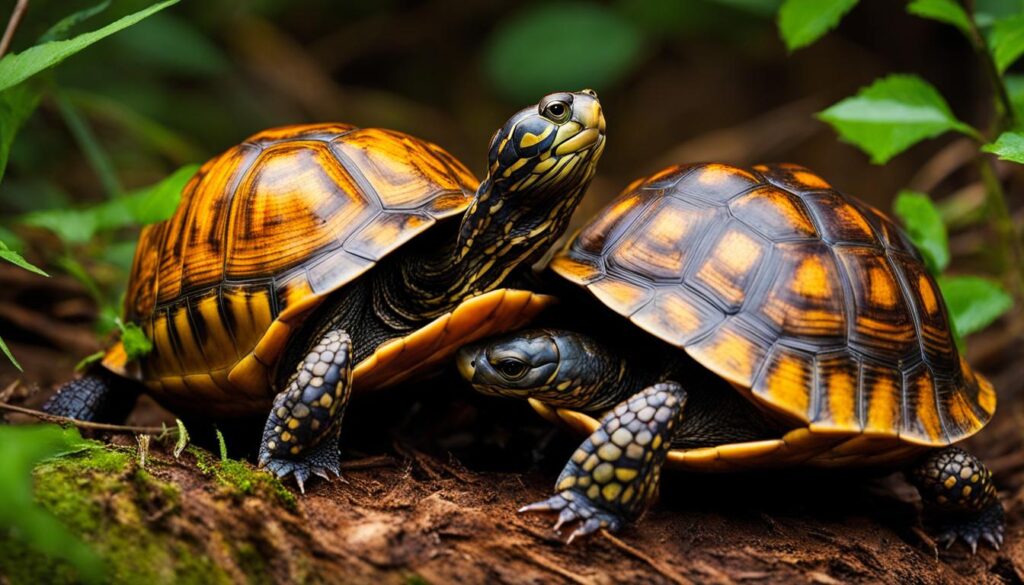
Table: Visual Cues for Sexing Box Turtles
| Visual Cues | Males | Females |
|---|---|---|
| Eye color | Red | Normal |
| Bottom shell | Flat or slightly concave | Concave curve |
Sexing Box Turtles: A Closer Look
Sexing box turtles can be challenging, but knowing the visual cues can help determine their gender. While not foolproof, these cues can provide insights into the turtle’s sex.
- Males: Male turtles often have red eyes, which can be more pronounced during the breeding season. They may also have a flat or slightly concave curve on the bottom of their shell.
- Females: Female turtles typically have normal eye color, and their bottom shell has a concave curve. This curve allows for easier egg laying.
Setting Up the Proper Enclosure
Creating a suitable environment for breeding box turtles is essential for their health and successful mating. To ensure a proper setup, it is important to consider several factors. The enclosure should provide fresh water for soaking and drinking, as turtles require regular hydration. A shallow dish or a small pond area can be included to meet their water needs. Additionally, a heat lamp should be installed to maintain the ideal temperature range for the turtles. This will help regulate their body temperature and stimulate breeding behavior.
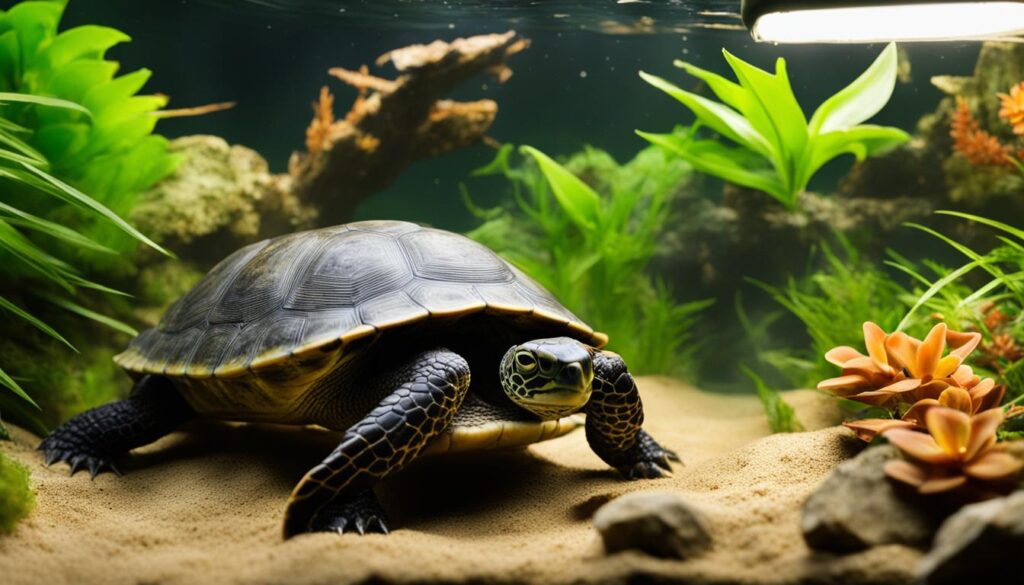
Provision of hiding spaces is another crucial aspect of the enclosure. Turtles naturally seek shelter and security, so it is recommended to incorporate various types of hiding spaces, such as rocks, logs, or dense vegetation. These hiding spots will provide the turtles with a sense of safety and privacy, encouraging their natural mating instincts. Furthermore, a balanced diet is vital for the health and reproductive success of box turtles. Their diet should consist of a combination of meat and plant matter to ensure they receive the necessary nutrients.
It is important to create a well-structured and visually engaging enclosure for box turtles. Here is a table summarizing the essential components:
| Components | Description |
|---|---|
| Fresh Water | A shallow dish or a small pond area for soaking and drinking. |
| Heat Lamp | To maintain the ideal temperature range for the turtles. |
| Hiding Spaces | Rocks, logs, or dense vegetation to provide shelter and security. |
| Balanced Diet | A combination of meat and plant matter for proper nutrition. |
By ensuring the proper setup of the enclosure, box turtle breeders can provide a suitable environment for their turtles’ reproductive needs. This will enhance the chances of successful mating and the overall health and well-being of the turtles.
Understanding the Breeding Season and Egg Laying
The breeding season for turtles varies depending on the species and their natural habitats. It is essential to understand the timing of the breeding season and the process of egg laying to ensure successful reproduction. The breeding season typically occurs in early spring, around March or April, when turtles experience mating urges. However, it is recommended to isolate the breeders from this point until summer to maximize their chances of successful breeding.
After the mating process, female turtles start looking for a suitable place to lay their eggs. This usually happens in June, although the exact timing can vary. Female turtles will bury their eggs in sandy areas to protect them from predators. Once laid, the eggs take about 80 days to hatch, although this timeframe can be influenced by factors such as temperature. It can be challenging to determine when the eggs have been laid, as the mother will conceal them. Monitoring the female’s behavior and occasional checkups can provide insight into the egg-laying process.
Understanding the breeding season and egg-laying process is crucial for those interested in breeding turtles. By closely observing and tracking the behavior of female turtles, breeders can ensure the health and safety of both the mother and the developing eggs. It is important to create a suitable environment for the eggs, maintaining the appropriate temperature and humidity. By providing the necessary care and attention during the breeding season and egg-laying process, breeders can increase the chances of successful hatching and the growth of healthy hatchlings.
“The breeding season typically occurs in early spring, around March or April, when turtles experience mating urges.”
– Turtle Breeding Expert
The Timing of Egg Laying and Hatchling Timeframe
After the eggs have been laid by the female turtle, they will undergo an incubation period of approximately 80 days. This timeframe can vary depending on factors such as temperature and humidity. It is important to ensure that the eggs are kept in a suitable environment during this period to maximize the chances of successful hatching.
Once the eggs hatch, the timing of the emergence of the hatchlings can vary. Some hatchlings may emerge from the nest shortly after hatching, while others may take some time to make their way to the surface. It is crucial not to interfere with the natural process of hatchlings making their way to the water. Their journey from the nest to the water is essential for their survival and development.
During their first year of life, hatchlings are particularly vulnerable to the elements and have a high mortality rate. Providing a safe indoor enclosure with a suitable diet high in protein, such as small bugs, can greatly enhance their chances of survival and growth. It is important to closely monitor the health and development of the hatchlings during this crucial period.

Caring for Eggs and Hatchlings
Once the female turtle has laid her eggs, it is important to provide the necessary care to ensure their successful incubation and the survival of the hatchlings. The incubation period for turtle eggs can vary depending on the species and environmental conditions. On average, it takes about 6 to 8 weeks for the eggs to hatch.
During this time, it is crucial to maintain a stable temperature and humidity level in the incubation environment. A temperature of around 80 to 85 degrees Fahrenheit (27 to 29 degrees Celsius) is ideal for most turtle species. The humidity should be kept at around 80 to 90 percent to prevent the eggs from drying out.
Hatchlings are delicate and require special care. Once they have emerged from the eggs, it is best to leave them in the incubation chamber for a few days to allow them to fully absorb their yolk sacs. After this period, they can be carefully transferred to a suitable enclosure with a warm and humid environment.
| Hatchling Diet | Feeding Frequency |
|---|---|
| Commercial turtle food pellets | Once a day |
| Small insects (such as crickets or mealworms) | 2-3 times a week |
| Leafy greens and vegetables (such as lettuce and carrots) | 2-3 times a week |
| Calcium and vitamin supplements | Once a week |
Proper nutrition is crucial for the healthy growth and development of hatchlings. A balanced diet should include commercial turtle food pellets, small insects, and leafy greens. It is important to provide a variety of food to ensure they receive all the necessary nutrients. Additionally, calcium and vitamin supplements should be provided once a week to support their shell and overall health.
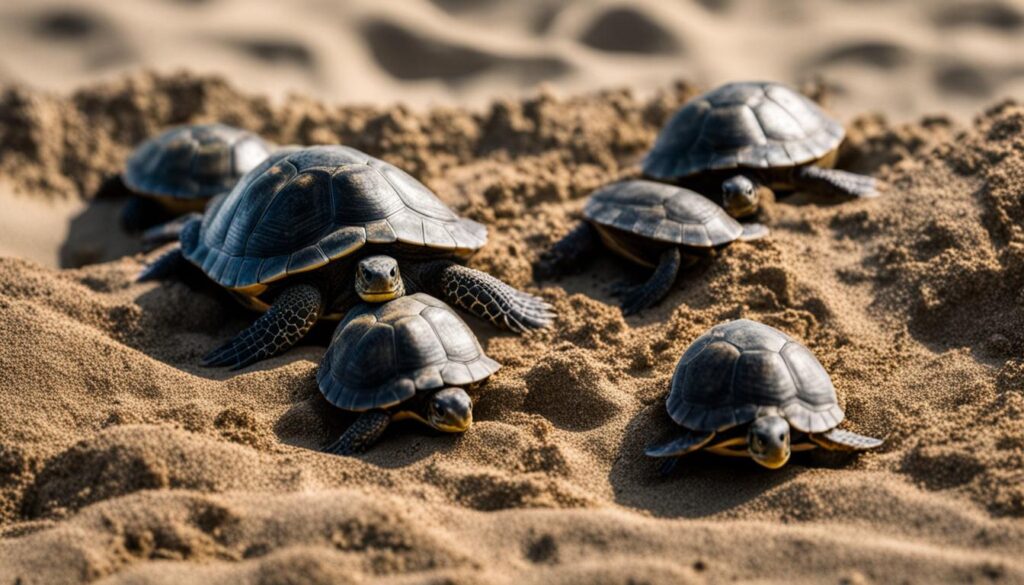
Remember to monitor the hatchlings closely for any signs of illness or stress. Provide them with a safe and secure enclosure with proper heating and lighting. It is also advisable to consult a reptile veterinarian for guidance on caring for hatchlings and addressing any health concerns.
Sea Turtles Mating Season
Sea turtles, including the green turtle, loggerhead turtle, hawksbill turtle, olive ridley turtle, Kemp’s ridley turtle, and leatherback turtle, have their own mating seasons. These seasons can vary based on the species and location, but they generally occur in warmer months. For example, the green turtle mating season typically takes place from June to September, while the loggerhead turtle mating season is from May to August.
In these species, mating behavior can be observed, including males actively pursuing females and engaging in courtship displays. During the mating season, males will chase after females, often biting their flippers or shells to gain their attention. Once a male successfully mates with a female, she will store the sperm internally and use it to fertilize multiple clutches of eggs throughout the season. It is fascinating to witness these intricate rituals and displays of courtship in the sea turtle mating process.
| Sea Turtle Species | Mating Season |
|---|---|
| Green Turtle | June to September |
| Loggerhead Turtle | May to August |
| Hawksbill Turtle | Year-round, with peaks in summer |
| Olive Ridley Turtle | Year-round, with peaks in winter |
| Kemp’s Ridley Turtle | Year-round, with peaks in summer |
| Leatherback Turtle | Year-round, with peaks in summer |
The specific mating behaviors and environmental factors that trigger the mating season of sea turtles vary between species. However, in general, the warmer months provide optimal conditions for mating, nesting, and hatching. It is important to note that sea turtles are protected species, and it is crucial to respect their natural habitats and mating behaviors.
Sea Turtle Conservation
Sea turtles are facing numerous threats that have led to the decline of their populations worldwide. Understanding these threats and taking action to conserve these magnificent creatures is crucial for their survival.
Threats to Sea Turtles
Sea turtles face various threats, including habitat loss, pollution, entanglement in fishing gear, and poaching. A significant threat to their nesting habitats is coastal development and the destruction of nesting beaches. Pollution, such as plastic debris and oil spills, can harm sea turtles through ingestion and entanglement. They are also at risk of drowning as they can become trapped in fishing nets and gear. Moreover, sea turtle populations are targeted by illegal poaching for their eggs, meat, and shells, further endangering their survival.
Conservation Status and Efforts
As a result of these threats, many sea turtle species are classified as endangered or critically endangered. Conservation efforts are critical to protect and restore their populations. Various organizations and initiatives are focused on sea turtle conservation, such as habitat protection, nesting beach monitoring and management, education and awareness programs, and research on sea turtle biology and behavior. Additionally, international agreements and regulations, such as the Convention on International Trade in Endangered Species of Wild Fauna and Flora (CITES), aim to regulate and control the trade of sea turtle products.
How to Help Sea Turtles
Individuals can play an active role in sea turtle conservation by taking simple yet impactful actions. Here are some ways to help:
- Reduce the use of single-use plastics, which can end up in the ocean and harm sea turtles.
- Participate in beach cleanups to remove litter and debris that can be harmful to sea turtles and other marine life.
- Support local conservation organizations dedicated to sea turtle protection and restoration.
- Report any sea turtle sightings or nesting activities to relevant authorities to contribute to research and monitoring efforts.
By coming together and taking these steps, we can contribute to the conservation of sea turtles and ensure their survival for generations to come.
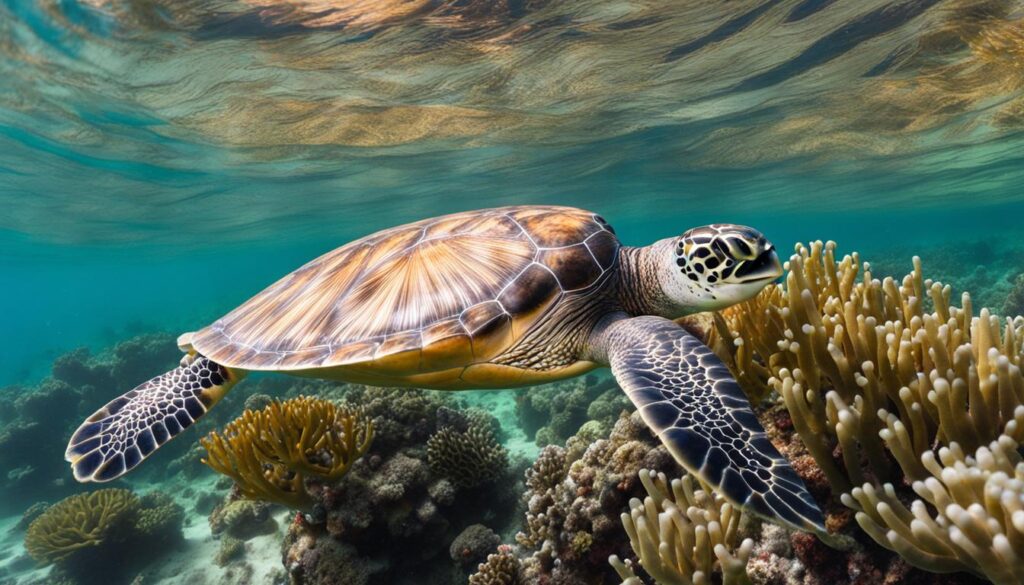
Sea Turtle Facts and FAQs
Sea turtles are incredible creatures that have captivated the imagination of people around the world. Here are some fascinating facts about sea turtles:
- There are seven species of sea turtles: the green turtle, loggerhead turtle, hawksbill turtle, olive ridley turtle, Kemp’s ridley turtle, flatback turtle, and leatherback turtle. Each species has its own unique characteristics and behaviors.
- Sea turtles have been around for more than 100 million years, making them some of the oldest creatures on Earth. They have survived the extinction of the dinosaurs and have adapted to various ocean environments.
- Sea turtles are well-known for their long migrations. Some individuals travel thousands of miles across the ocean, returning to the same beaches where they were born to lay their eggs.
- Female sea turtles lay their eggs on sandy beaches, digging a nest in the sand and burying the eggs to protect them from predators. The temperature of the nest determines the sex of the hatchlings.
- Sea turtles play a crucial role in marine ecosystems. They help maintain the health of seagrass beds and coral reefs by feeding on seagrass and controlling the populations of sea sponges and jellyfish, which can become overabundant without natural predators.
“Sea turtles are fascinating creatures that have evolved over millions of years to survive in the harsh marine environment. Their ability to navigate the vast oceans and return to the same nesting beaches year after year is truly remarkable.”
– Marine Biologist
Sea Turtle FAQs
Here are answers to some frequently asked questions about sea turtles:
- Are sea turtles endangered? Yes, several species of sea turtles are endangered or critically endangered. They face numerous threats, including habitat loss, pollution, entanglement in fishing gear, and poaching. Conservation efforts are crucial to protect these magnificent creatures.
- How long do sea turtles live? Sea turtles have long lifespans, with some individuals living up to 80 years or more. However, the exact lifespan varies depending on the species.
- Do sea turtles have teeth? Sea turtles have a beak-like structure instead of teeth. This adaptation allows them to feed on a variety of marine plants and animals, including seagrass, jellyfish, and sponges.
- How fast can sea turtles swim? Sea turtles are surprisingly agile swimmers. While their speed varies depending on the species, some sea turtles can reach speeds of up to 20 miles per hour.
Learning about sea turtles and their incredible journeys can inspire us to protect these magnificent creatures and preserve their natural habitats for future generations to enjoy.

Recommended Books on Turtles
For those interested in learning more about turtles and their care, there are several recommended books available. These books cover a wide range of topics, from turtle biology and behavior to conservation efforts. Whether you’re a beginner looking for basic care information or an experienced turtle enthusiast wanting to delve deeper into the world of turtles, these books can provide valuable insights and knowledge.
- Turtles of the World: A Guide to Every Family by Jeffrey E. Lovich and Whit Gibbons: This comprehensive guide offers detailed information on the different species of turtles found around the world. It covers their habitats, behavior, and conservation status, making it an essential resource for anyone interested in turtles.
- Biology and Conservation of North American Tortoises edited by David C. Rostal, Earl D. McCoy, and Henry R. Mushinsky: This book focuses specifically on North American tortoises and provides in-depth information on their biology, ecology, and conservation efforts. It is a valuable resource for researchers, conservationists, and anyone passionate about these fascinating creatures.
- Life in a Shell: A Physiologist’s View of a Turtle by Donald C. Jackson: This book takes a unique approach to exploring the inner workings of turtles. It delves into the physiology and anatomy of turtles, offering a deeper understanding of their unique adaptations and biological functions.
“Turtles of the World: A Guide to Every Family” offers detailed information on the different species of turtles found around the world.
These are just a few examples of the many great books available on turtles. Whether you’re interested in turtle care, sea turtle conservation, or simply want to learn more about these incredible creatures, these books have you covered. Happy reading!

Other Turtle-Related Books
If you’re looking for more turtle-related books beyond those focused on care and biology, there are several options to consider. From novels to children’s books to humorous tales, these titles offer a range of stories centered around turtles and tortoises.
Novels:
“Tortoise Soup” by Jessica Speart is a captivating mystery novel that combines suspense with the fascinating world of desert tortoises. The story follows wildlife investigator Rachel Porter as she uncovers a sinister plot involving the illegal trade of these majestic creatures.
Children’s Books:
“Thunder on the Desert” by Jay B. Winderman is an engaging children’s book that introduces young readers to the adventures of Thunder, a desert tortoise. Through Thunder’s journey, children learn about the unique characteristics of these slow and steady creatures.
Humorous Tales:
If you’re looking for a light-hearted read, “Turtle Confusion: A Satirical Look at the Lives of Turtles” by Wanda Oleson is a humorous exploration of the quirks and idiosyncrasies of turtles. With witty anecdotes and clever observations, this book is sure to bring a smile to your face.
Whether you’re in the mood for a thrilling mystery, a heartwarming children’s tale, or a humorous journey, these turtle-related books offer something for everyone. So sit back, relax, and dive into the captivating world of these amazing creatures.
Conclusion
Throughout this article, we have explored the fascinating world of turtles mating and breeding. From finding a suitable pair of turtles to setting up the perfect enclosure, we have covered the essential aspects of caring for these incredible creatures. Understanding the breeding season and the timing of egg laying is crucial for successful reproduction, and proper care for the eggs and hatchlings is essential for their survival.
Additionally, we have delved into the mating habits and conservation efforts of sea turtles. These magnificent creatures face numerous threats, making conservation initiatives vital for their survival. By supporting local organizations, reducing plastic usage, and reporting sightings, we can all contribute to the protection of these ancient species.
Whether you are interested in breeding box turtles or learning more about sea turtles, this article has provided valuable insights and resources. By gaining knowledge and taking action, we can make a difference in the preservation of these remarkable animals. Let’s continue to appreciate their beauty and work towards their conservation.
FAQ
What should I look for when finding a suitable pair of turtles for breeding?
It’s important to find turtles of opposite gender and the same species. Breeding related turtles should be avoided to prevent genetic abnormalities. Sexing the turtles can be done visually, but a vet examination can provide accurate identification.
How should I set up the enclosure for breeding box turtles?
The enclosure should include fresh water, a heat lamp for temperature regulation, hiding spaces, and a balanced diet. The walls of the enclosure should not be see-through to prevent stress in the turtles.
When is the breeding season for box turtles and how long does it take for the eggs to hatch?
The breeding season typically occurs in early spring, with egg laying happening in June. The eggs take about 80 days to hatch, with some variation based on temperature.
How should I care for the eggs and hatchlings?
It’s best to leave the mother to care for the eggs herself. The eggs should be left in the nest chamber to incubate on their own. Once the hatchlings emerge, they should be left to make their way to the water on their own. Providing a safe indoor enclosure and a diet high in protein can help ensure their survival and growth.
When is the mating season for sea turtles?
The mating season for sea turtles varies based on the species and location, but it generally occurs in warmer months. For example, the green turtle mating season typically takes place from June to September.
How can I contribute to sea turtle conservation?
Individuals can support local conservation organizations, participate in beach cleanups, reduce the use of single-use plastics, and report any sea turtle sightings or nesting activities to relevant authorities. Efforts to protect nesting beaches and enforce fishing regulations are also important for their conservation.
How many species of sea turtles are there?
There are seven species of sea turtles found worldwide, including the green turtle, loggerhead turtle, hawksbill turtle, olive ridley turtle, Kemp’s ridley turtle, flatback turtle, and leatherback turtle.
Are there any recommended books on turtles?
Yes, some recommended books include “Turtles of the World: A Guide to Every Family” by Jeffrey E. Lovich and Whit Gibbons, “Biology and Conservation of North American Tortoises” edited by David C. Rostal, Earl D. McCoy, and Henry R. Mushinsky, and “Life in a Shell: A Physiologist’s View of a Turtle” by Donald C. Jackson.
Are there any turtle-related novels or children’s books available?
Yes, some recommendations include “Tortoise Soup” by Jessica Speart and “Thunder on the Desert” by Jay B. Winderman.





